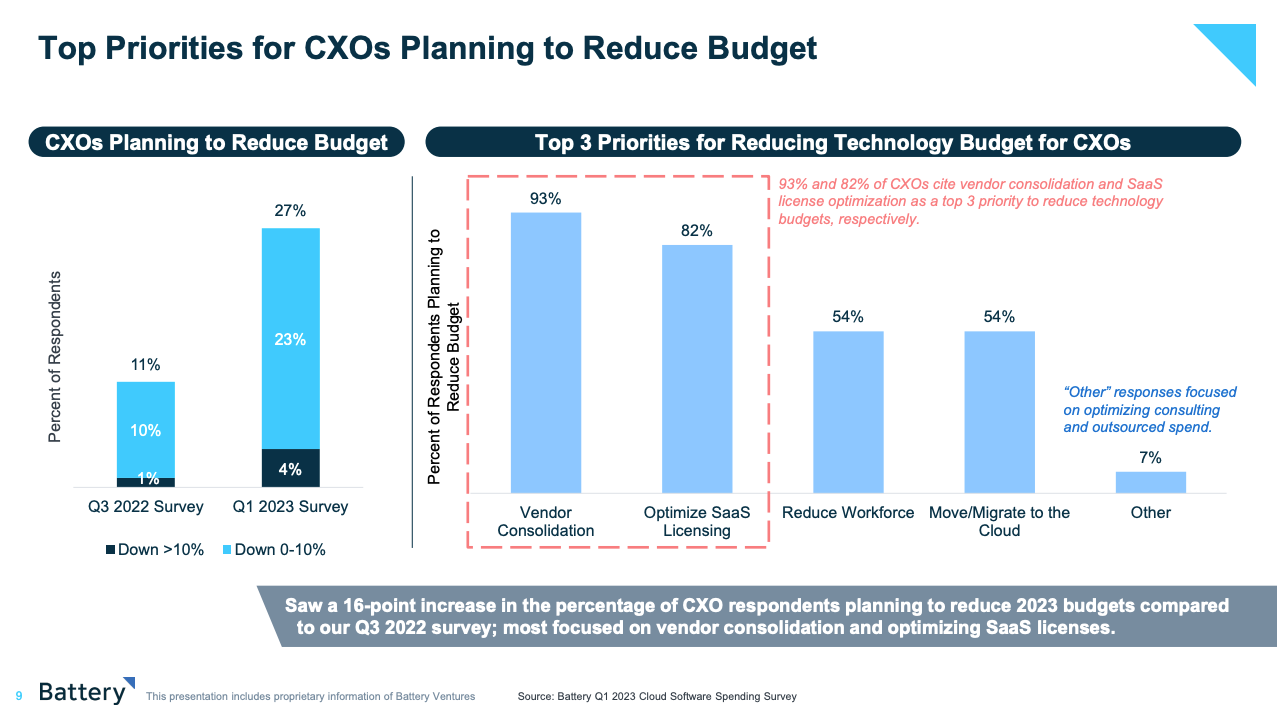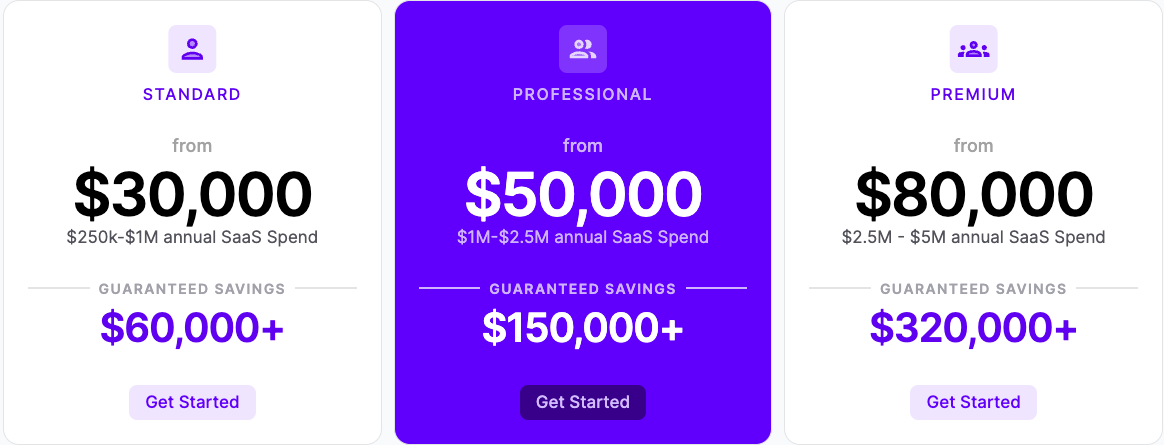How to use Vertice to reduce your SaaS spend
In the March 2023 Battery Ventures State of Cloud Spending report 27% of CxOs were planning to reduce their tech budgets.
And of those, the top two priorities were Vendor Consolidation and Optimising SaaS licensing.
Compared to legacy IT solutions requiring hardware and datacentres, SaaS is relatively easy to buy.
Business units purchase on their credit cards, SSO with Google or Microsoft is simple to implement, integrations are click and go, and before you know it your team is up and running with no involvement from IT or Finance.
In today’s economic climate, with the pressure on CXOs to drive profitable growth, the focus has now moved to stripping out wasted cost from this unregulated SaaS party.
How are companies wasting money on SaaS?
This ease of onboarding introduces four ways companies waste money in their SaaS purchases.
Buying SaaS that is not used
You purchased a tool for a specific purpose - to plan a project or design a product - but now that purpose is complete the licences are unused and still being paid for.
In some companies SaaS was bought by someone no longer in the business, and no-one knows whether it is being used.
Buying too many licences
You purchased a block of licences in the belief you would use them all, but adoption has not taken off.
You might have reduced headcount in the business and not reduced the number of licences you have under contract.
You might have added on modules or upgraded to an Enterprise plan that is not being used appropriately.
Buying multiple contracts
In larger companies you will find multiple contracts with the same vendor - because business units either didn’t know, or they felt it would slow them down to align with existing contracts.
These smaller contracts will not benefit from the better pricing of a consolidated deal.
Lack of negotiating power
Buying anything is knowledge arbitrage - who knows more than the other person.
When you buy a car you know what the recommended price is so you are able to negotiate effectively.
With SaaS, you don’t know what you should be paying for a contract like yours, so the vendor has the power.
How Vertice gives you control of SaaS spending
Vertice is a SaaS purchasing platform that helps companies to take control of this proliferation of poorly negotiated contracts.
Discovery and Usage Analysis
The first step is to understand what SaaS your company is using - across Vertice’s customer base companies have an average of around 75 different SaaS contracts.
You’ll provide Vertice with an extract from your accounting system, or you can walk the team through the tech stack you are aware of.
Using this information, along with integrations into your Single Sign On, the platform will analyse which contracts you have, when renewals are due, and how each SaaS tool is being used.
Audit your current contracts
Now you have a centralised list of all of the SaaS products your company is using, the Vertice team can use their knowledge of what a well negotiated contract looks like to audit your agreements and look for potential savings.
Across all four of the wasted spend categories you’ll find opportunities:
SaaS that isn’t used
SaaS that is over licenced
Duplicated contracts
Poor negotiation
Negotiate new contracts
Vertice is a technology enabled service provider.
That means they do more than provide the platform, they will actually manage the renewal negotiations on your behalf.
Based on the findings in the audit, the negotiation team will draw up a prioritised list of contracts that might be due for renewal, or good candidates for early renewal or cancellation.
The team will use their experience of managing tens of thousands of contracts to negotiate the most beneficial terms including contract length, contract consolidations and removing unused modules.
Vertice suggests customers should see annual savings of 20-30% on their SaaS spend - a significant amount to assign to other budgets.
Continual optimisation or renewals and new contracts
The Vertice dashboard makes it easy for your team to keep on top of upcoming renewals, and avoid the pressure that is placed on customers when renewals need to be executed with minimal notice.
When business units require new SaaS products, you can rely on the Vertice database and negotiators to ensure you get the appropriate pricing from the start of your agreement.
What does Vertice cost?
Pricing is based on your annual SaaS spend using the data that comes out of your accounting system. The larger your company, the more SaaS you’ll have, and the higher your SaaS spend.
Vertice is confident in the savings their provide to companies, so they’ll provide you with a guarantee that they’ll find those savings or you get your money back - making it a very low risk route to saving on your SaaS spend.
How I help your SaaS decision making
Reducing your SaaS spend is not just as simple as looking at the licences and stripping out cost.
In some cases you’ll find potential overlap in functionality and you will need to work with the relevant business units to assess their workflow and what they are trying to achieve.
In the revenue tech space particularly, there is a large amount of overlap as revenue intelligence, revenue enablement and revenue engagement platforms converge into a single category.
The combination of my tech stack audit and a platform like Vertice is a powerful one.
Get started
If you are considering finding out what your potential savings could be, then get in contact with Vertice directly.
If you want help assessing your revenue tech stack and assessing overlaps in functionality prior to stripping out that cost - then let’s discuss how I can help.
Get started
Whenever you are ready, there are two ways that I can help you with your RevOps tech stack.
Buyer Experience Audit - I’ll impersonate a buyer researching your segment and company and let you know what I find. Ideal for planning your RevOps strategy.
RevOps Impact Playbooks - I’ll help you implement one or more tactical processes across your revenue teams - content, referrals, testimonials, adoption and more.


